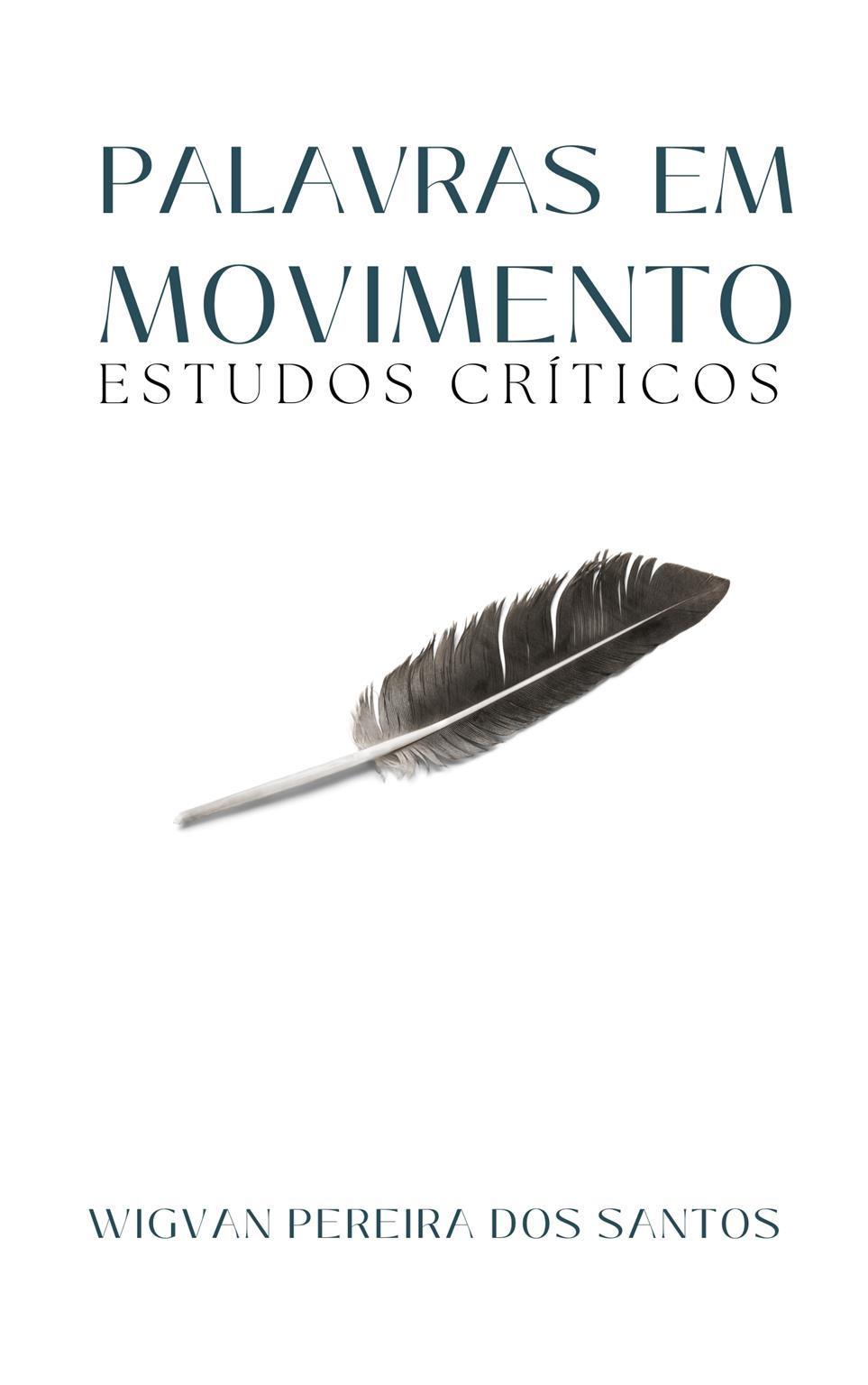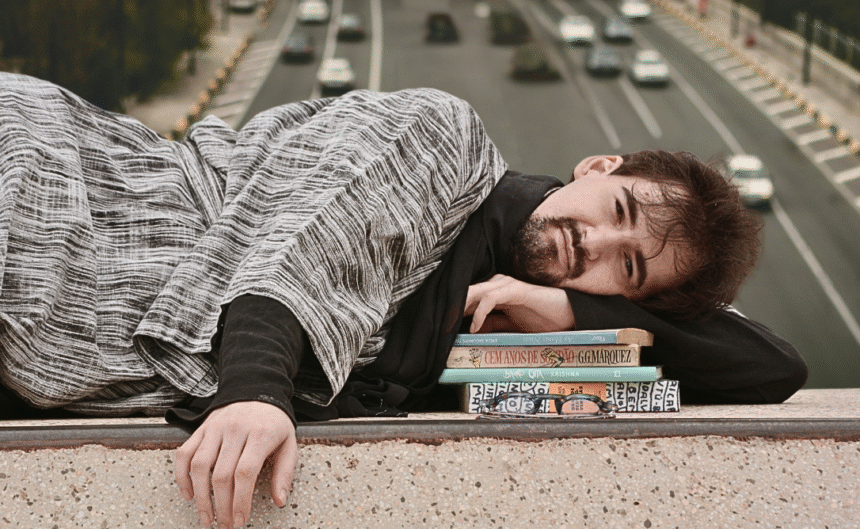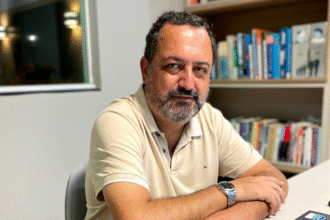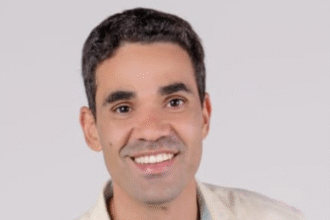With reflections that span literature, film, and philosophy, writer and professor Wigvan Pereira dos Santos launches “Words in Motion: Critical Studies,” a work that brings together five essays on contemporary themes such as motherhood, digital affections, cultural memory, and Eastern representations. With a keen eye on Goiás’s work and the influences of postcolonial criticism, the author proposes a critical reading of reality through artistic expressions and the constant transformation of meaning in everyday life.
Your book proposes dialogues between literature, philosophy, and everyday life—a trio that doesn’t always go hand in hand. What was it like finding this meeting point between such complex themes and ordinary life?
First of all, thank you so much for inviting me to answer these questions, which you asked with such care and attention. Regarding your question, finding a common ground between these three axes, which you so clearly understood—literature, philosophy, and everyday life—wasn’t necessarily something that required much effort for me, for several reasons. First, philosophy and literature entered my life very early. My sister, who is seven years older than me, trying to balance the time she spent with me, as in many Brazilian homes where older siblings care for younger ones while their parents work, with her own schoolwork, ended up transforming reading the novels she needed to read into something fun for me. So, for example, when I was six or seven, she had to read Dom Casmurro and suggested that we read a chapter or two a day together. She then asked me to find some words that defined that chapter—for example, “church,” “friendship”—and, finally, to find an image in a book, newspaper, or magazine to illustrate it. For me, it was light, fun, and, on top of that, I was spending time with my sister—many younger siblings I know have this kind of desire to spend time with their older siblings, in a way that truly engages in dialogue and exchange. At the same time, my mother was studying Education, and during her first semester, she took a Philosophy class and bought an introductory book on Philosophy—which, incidentally, was the only one she bought in her four years of college. She thought I might like it, so she gave it to me when she stopped using it. I read freely, regardless of timeline, driven solely by my interest, and we would talk about what I’d read once a week, usually on Fridays, while she did laundry. I believe this early education gave me an intuitive connection between literature and philosophy—and life, which is the subject of both. But this also comes from an attitude I have towards each book, each text that I propose to analyze: the attitude of listening to what the text is saying for itself.
The interesting thing is that we read the world, things, people, situations, and, of course, books, based on the entire collection we build within ourselves throughout our lives. And since I study philosophy—because we never finish studying philosophy—when I encounter a question in a book, when the book poses that question, or when I pose a question based on what the book presents, one of my ways of responding will be through philosophy—but I also use everything I think can add to the reading. For example, in an article I recently wrote about the notion of art in Hannah Arendt, I cited verses from a Miley Cyrus song in the epigraphs of the intertitles that I thought were pertinent to that dialogue. And I also look for things I don’t know, but that I think will help me answer those questions or formulate other, more interesting ones. For example, in “Words in Motion,” all the articles I wrote led me to seek out theorists I had never read. For example, Mikhail Bakhtin, whom I had never read, was the main reference in one of the articles. The notion of cultural memory, which isn’t something necessarily explored by philosophers, was the core of my argument in one of the articles. The texts I analyze—novels, short stories, and poems—I had never read before writing about them, with the exception of the novel “Without Words,” which I had already read over ten years ago and read with the perspective of a reader who wants to be entertained, not someone who needs to analyze them theoretically. They are two different approaches. And everyday life is precisely this bridge that helps us cross between literature and philosophy, between what is written and what can be read from it, between the reader’s perspective and the critic’s.
In your essay on motherhood, you discuss the line between sacralizing and monstrousizing this experience. What personal reflections did you experience as you delved into this symbolic portrayal of something so intimate and socially charged?
The idea of motherhood has long interested me, but it didn’t spark my interest through direct experience, so to speak, but rather through seeing its effects. Close friends became pregnant as teenagers, and this brought them a lot of anguish; the relationship my first partner’s mother had with him also touched me deeply, because she didn’t deal well with his sexuality, which caused them both great sadness; my sister’s desire to be a mother, which wasn’t easy to fulfill, leaving incurable scars. Among other stories, I’ve heard from students and friends who have made this issue ever present in some way. In my latest novel, “White Shoes,” the fundamental point is the relationship between four women and their teenage children, four ways of thinking and experiencing motherhood. Art is this place where we develop many things that exceed our structure, our stature, where we can practice seeing the world through the eyes of others.
I will never experience what it’s like to be a mother; that’s beyond me, but art, through reading a novel, through sculpture—Camille Claudel has some very interesting sculptures in this sense, for example—or when I myself produce a short story, a novel, a painting, a film, allows me to access a little of this phenomenon, so beautiful, so powerful, and so devastating. The question that led me to this article was: why is it that when a woman doesn’t live up to the ideal of motherhood, which is a historical, social, and political construct, she is relegated to the category of “monster”? The important thing is to remember that the sacralization of motherhood is also a form of dehumanization, a way of stripping women of their human attributes, such as desire and fatigue, for example, of denying them the right to rest by investing them in the fulfillment of a sacred mission that is an additional burden, on top of all the unpaid and unappreciated work required of them. Perhaps, in this sense, we could even say that the monstrousization of a woman who refuses to assume all this historical and political burden that falls on her shoulders, although unfair, is a lesser weight than the obligation of being this sacred mother.
When analyzing the book “Sentences,” you delve into emotional relationships in cyberspace. How do you see the effects of technology on our emotions and bonds—especially in times of constant, yet sometimes superficial, communication?
I almost always see technology in a positive light, including for human relationships. For example, when I was a teenager living in the countryside of Goiás, without other teenagers around who were discovering that their sexualities didn’t quite conform to what society considers appropriate, I managed to make friends in chat rooms, which I used at school, at internet cafes, and, after a while, at home, when my sister got internet access. And this experience was very important to me. These virtual relationships, with people whose names I don’t even know and with whom I never had contact again, were fundamental for me to understand my place in the world. So, what is superficial? I had other relationships, with relatives, neighbors, and friends, who frequented my house, but with whom I didn’t have the opportunity to discuss these topics because I didn’t want to expose myself to them at that moment, not for fear of not being welcomed, but it was a dialogue I wanted to have with someone who was like me and not someone who was seeing the issue from the outside.
I even met a girl whose name I never knew, but in the two years we talked, she introduced me to Almodóvar, Fellini, books I wouldn’t otherwise read, music I wouldn’t otherwise listen to, and it was very interesting. Besides, that webcam and microphone were luxury items, so it was always in writing. I keep wondering what the difference is between chatting with a virtual friend and the practice of hypomnemata —which, among other functions, served as a process of self-development before the eyes of another. And what’s deeper: a virtual relationship with someone with whom you exchange feelings, thoughts, perceptions, pains, joys, or a relationship in which the other person is present but with whom you only talk about trivialities? I think that social relationships, whether in person or online, have the depth that the individual is willing to embrace. Virtual relationships are not superficial by nature, nor are in-person relationships the ones that will most fulfill our spirit. The depth of the relationship depends on the individual, not on the physical presence of the other. I have two friends with whom I’ve been communicating virtually for fifteen years, but whom I’ve never seen in person. And I have coworkers with whom I interact daily who know nothing about me. Instead of thinking about how technology can negatively impact the building of lasting bonds, perhaps it would be more interesting to consider whether technology isn’t just another subterfuge to mask our lack of ethical commitment to others. I believe this is the core of the breakdown in human relationships we’ve witnessed, not just the advent of communication technologies.
You argue that the short film “Hugo” helps fill in the gaps in an author’s biography through imagination. To what extent, in your opinion, can (or should) fiction influence a people’s cultural memory?
In fact, the relevance of the film “Hugo” to the cultural memory of Goiás is not to fill biographical gaps. Filmmaker Lázaro Ribeiro interpreted the documents he had access to, conversations with family members, and the texts written by Hugo de Carvalho Ramos himself. Imagination plays a role in the film, for example regarding the writer’s sexuality, but there is a commitment to not straying too far from what the documents say. Many biopics lack this same commitment, and this makes it difficult for us to use certain films even as teaching resources in the classroom. If the facts are distorted, not just interpreted, if they are very far from what the documents say, then its value is merely entertainment. It can be a great film; the fact that it distorts history doesn’t make it a bad film, just as an extremely historically accurate film can be a terrible film in terms of cinematic language. We humans greatly enjoy fiction. Fiction has been present since the beginning of wall paintings and has spread throughout all eras.
People will always create narratives to celebrate their founding heroes and to reinforce values to be cultivated by new generations. So, a film, especially a good film, even if it’s not a historical or biographical film, will contribute to cultural memory. Just yesterday, I was rewatching Hitchcock’s Rope, a film that remains fresh and bold despite being produced in the 1940s. It’s an adaptation of a play of the same name by English playwright Patrick Hamilton, which, they say, is based on a real case: the murder of a 14-year-old boy by his classmates. The film, then, is a work of fiction adapted from another work of fiction, but it records the anatomy of human destructiveness in a timeless way that can help us reflect on our own time. So, in some ways, we could say that it’s a work of fiction that contributes to cultural memory, as it was a fictionalization of a real crime from the killers’ perspective. The play is from 1929, the crime occurred in 1924, a recent crime, still intriguing – at that time, there were no true crime documentaries or YouTube channels, so I imagine the play had a major impact on that society and contributed in some way to the processing of that trauma. I don’t know, I’m fictionalizing it. It’s in a different sense than the short film “Hugo,” therefore, whose value is precisely to give a body, a face, a voice to a writer so important to our literature, a way of making him present to new generations who often don’t even know he existed. So, both well-made fiction, and biopics that present specific alterations for aesthetic purposes but remain committed to what the documents say, but also documentaries, of course, can contribute to cultural memory. Interfere, I don’t know. Because when you talk about interference, it makes me think of Prometheus bringing fire to humanity and making them more independent of the gods, and I don’t know if that’s what the fiction or the adaptation intends to do. But it’s possible. I just haven’t thought about it enough to give a more assertive answer. I did a thought exercise here.

Your book discusses colonial stereotypes and proposes a less Westernized perspective on the world. What led you to challenge this perspective, and what was the personal impact of revisiting these narratives from different perspectives?
I began thinking about colonialism while still in Philosophy school, seeing that our curriculum was predominantly composed of European philosophers—who are relevant, of course, that’s undeniable. However, I missed a debate that considered other realities. I managed to pass a highly competitive exchange program and was able to study for a year at the University of Minho in Portugal, but I had already completed my required course load, so I took classes in literature, art history, theater, and film. In the African literature courses, especially the Literature and Culture of Cape Verde, I first encountered this critical view of colonialism: Homi K. Bhabha, Edward Said, Gayatri Spivak, Stuart Hall, Joseph Ki-Zerbo, as well as the artists themselves, Noémia de Sousa, José Craveirinha, Orlanda Amarílis, Germano Almeida – on whom I did my master’s research at USP.
In literature, this is a debate that has been ongoing for at least three decades. Interestingly, it was in Portugal, not Brazil, that I first encountered this thought, and it shaped my entire intellectual and professional trajectory from then on. This is what led me to return to the University of Minho last year for a new doctorate, the courses of which motivated me to write the essays that appear in my book, Words in Motion.
Working with such diverse authors and works—from Goiás to India—you traverse various cultural geographies. How have these symbolic journeys shaped your understanding of Brazil and your own identity?
These aren’t just symbolic journeys. I’ve been—living or on long trips—to several countries and regions of Brazil, always for study and work. It was a purpose I had very clear from the moment I entered university: that I wanted to think about different places, to broaden my inner world. A philosopher, Vilem Flusser, says something like this: when we are foreigners in a place, we lift the veil of habit from our eyes and, thus, we can think differently. It’s as if not belonging to a place helps us explore other realms of thought. Flusser took this to a radical level, writing in several languages, including Portuguese. The world I live in is never enough for me. I always need to seek out other worlds to continue feeling alive. These essays—from Goiás to India—as you pointed out, were produced in Portugal.
Being a foreigner is always a process of adaptation, of finding a new way of speaking, of finding new ways of writing. If we’re too stuck in ourselves, we can’t fully take advantage of the world and all the learning opportunities it offers. It’s important to let go of the image we’ve built of ourselves, or at least be willing to negotiate with it, so we can be permeated by the other—another country, another culture, another way of thinking about our relationship with knowledge, in this case. And, from afar, we can see with some clarity that only distance makes possible all the good things we have in our country, in our culture, in our people. We have many things to be proud of in our country, despite all the pessimism that sometimes prevails.
At various points in the book, you seem to suggest that nothing is fixed—not truth, not knowledge, not art. Do you believe this fluidity is liberating, or can it sometimes also be a burden?
I honestly don’t know if I suggest this in my book, but I respect your interpretation. I would put it this way: I would say that what we understand as truth is traversed by countless lines of force—politics, religion, customs, sociability. We often think that things are the way they are because there’s no other way for them to be, when in reality, our concepts were all produced, they didn’t fall from the sky or a tree—maybe only Newton’s fell from a tree, lol. Paradigms are constantly changing. You asked me earlier about technology and how it affects human relationships: this shows that a paradigm of affective relationships that developed only through direct, face-to-face contact has given way to a paradigm in which relationships can be built between people in other parts of the world. But before that, there was also a paradigm of relationships that developed through phone calls, before that through letters—and we don’t even need to go back that far. The photographs that we used to print and distribute among the people we loved are now all posted on social media. These changes raise new ethical questions and require regulatory interventions—for example, there’s a very important legal and ethical debate surrounding the use of generative Artificial Intelligence. So, I wouldn’t use the word “fluidity” because it seems to convey the idea that these changes are as mellifluous as a boat ride on a lake at sunset, like the passage of time in a Manoel Carlos soap opera. All these changes that occur are painful, involving battles in the realm of ideas and sometimes even in the physical realm, producing some instability until they’re truly established, not always well-accepted by everyone, or even understood. They’re also the result of techniques, studies, and investment in research.
Da Vinci had a major impact on art history, but his technique is the result of much dedication, observation, and practice. Caravaggio took years to develop his lights and shadows. Van Gogh dedicated time to each nuance of his Starry Night. Generations often don’t understand each other because they were forged in very different contexts; we can see this, for example, in a case where Monteiro Lobato criticizes Anita Malfatti’s work. If art, knowledge, and truth are not fixed, it’s because human beings are not fixed. We will always be impacted by what surrounds us, and what surrounds us is the result of factors beyond our control. If this is a burden… well, being thrown into a world with so many possibilities will always bring a dose of anguish, but it can also bring a dose of libido, depending on how we face our own existence.
The work was produced with support from an arts training grant, demonstrating that your work also engages with cultural policies. How do you see the role of art and criticism at this time when the country is seeking to rebuild cultural and social ties?
The support from the Goiás Art and Culture Fund’s Training Actions call (2023) makes me reflect on the extent to which art depends on material and institutional conditions to exist socially. When work like mine is only realized thanks to public policy, it highlights that art is not just a matter of individual talent or inspiration, but the result of collective choice about what deserves to circulate, be seen, and be thought about. There is, then, a social dimension to art: it can only propose other forms of community if there is some agreement to invest in artistic and intellectual production as a political matter.
Criticism occupies an ambiguous place in this scenario. On the one hand, it can function as a mediator, opening the work to interpretation, denaturalizing the given meanings, and creating fissures in consensus. On the other, it risks being confined to a closed circuit of experts, which sometimes distances the production from the broader public debate. The challenge is to find forms of criticism that don’t remain stuck on Mount Olympus, that descend to the polis , that create tension, question, and return uncomfortable and necessary questions to society. Criticism has a formative dimension that cannot be lost sight of.
In times of rebuilding cultural and social ties, it seems that art and criticism can help reframe the question of how we want to live together, what sustains a common horizon, what can still be said and heard. This leads me to believe that perhaps it’s less about reconstituting something lost and more about inventing languages and spaces to create presence and meaning, in the face of the ruins and silences of what has been undone.
I think of the encounter with art as that point where we recognize ourselves a little in the other, or feel the discomfort of difference and realize that there are other ways of thinking. Therefore, I believe that art, in all its forms, can create possibilities for dialogue and listening, for reflecting on oneself through contact with this other who, although not always comprehensible, is fundamental for us to build a shared world together. Beyond canonical spaces—museums, universities, libraries—art needs to be increasingly integrated into the life of the city, the streets, and the peripheries, not only so that people can develop as audiences, but mainly by creating opportunities for people to develop their skills and express themselves as artists.
Follow Wigvan Pereira dos Santos on Instagram





